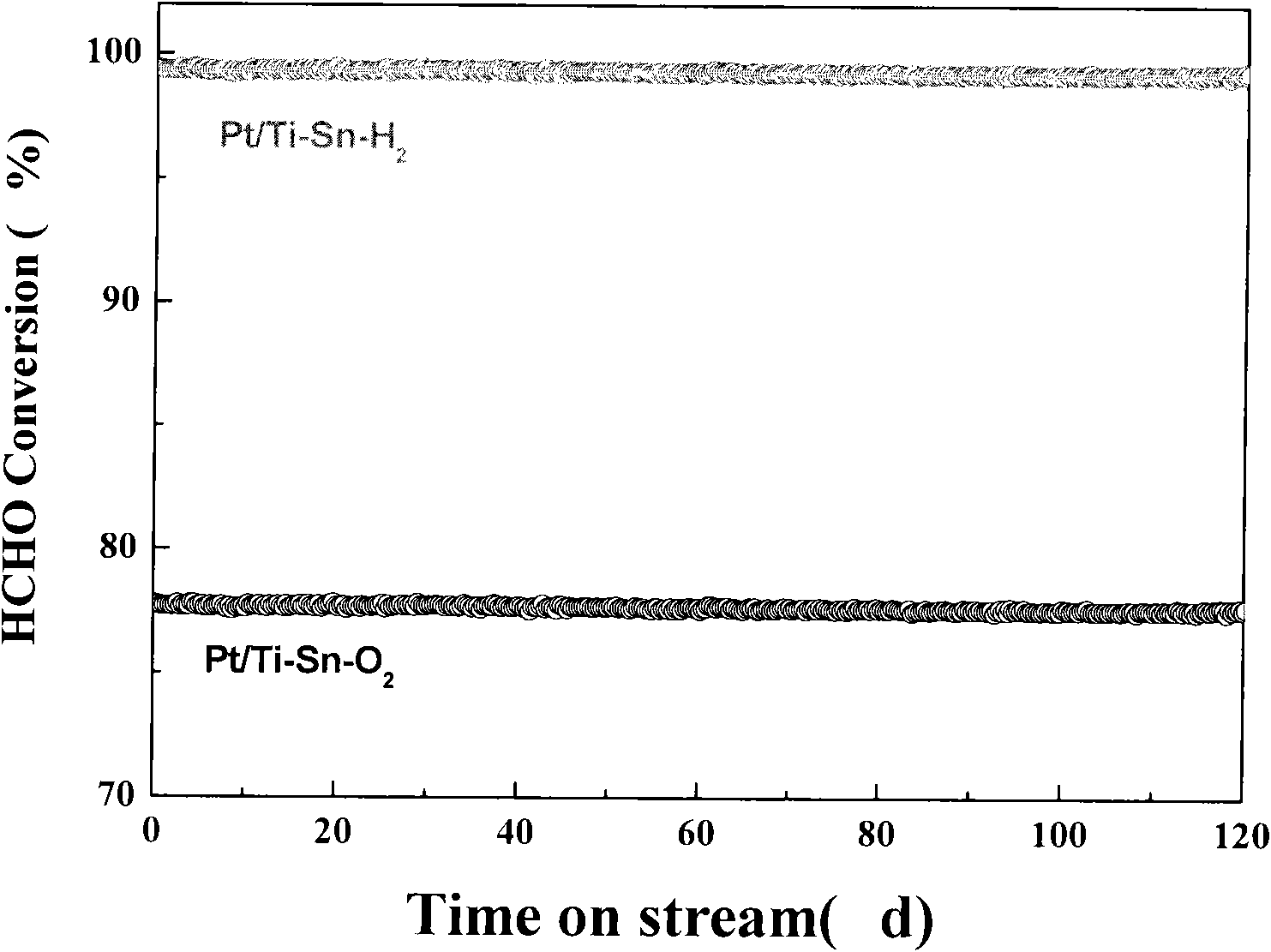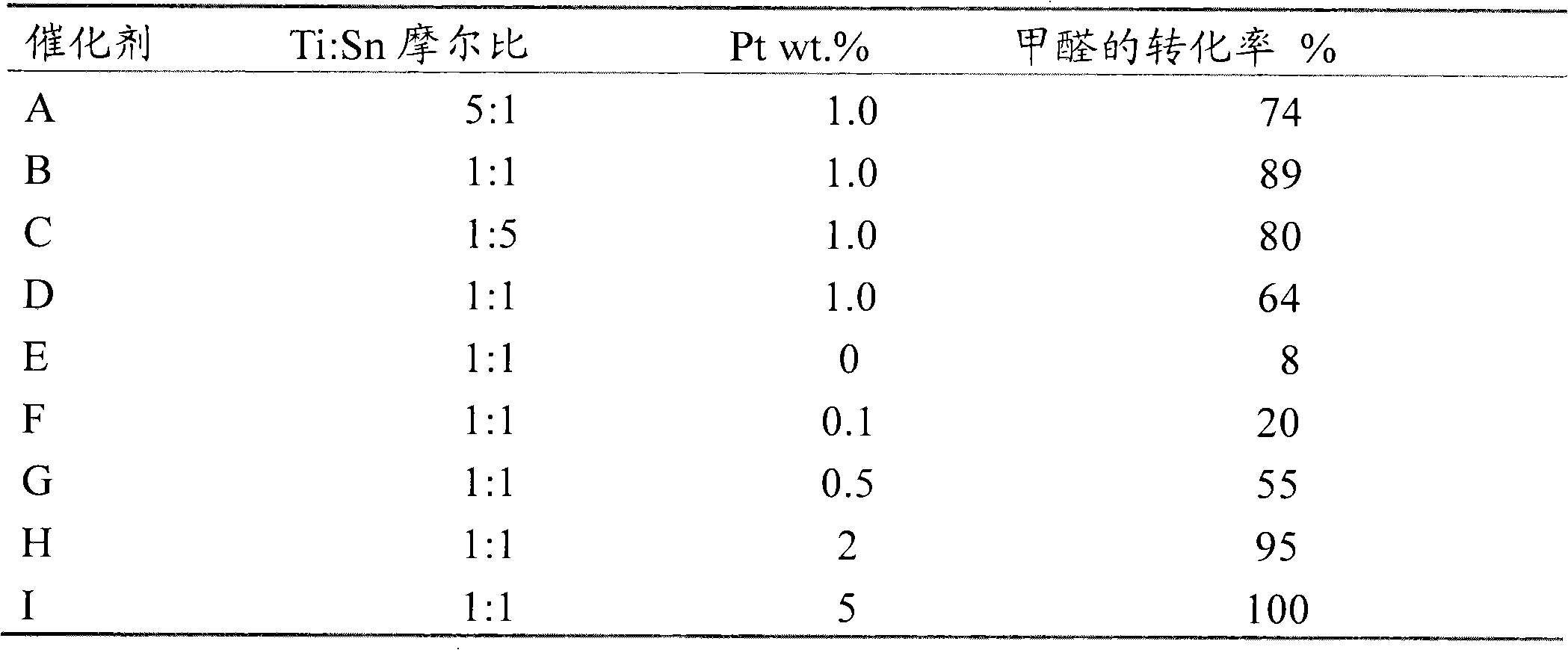High-efficiency catalyst for removing formaldehyde at room temperature
A catalyst, room temperature technology, applied at room temperature to eliminate pollution, can solve the problem of expensive catalysts and other issues
- Summary
- Abstract
- Description
- Claims
- Application Information
AI Technical Summary
Problems solved by technology
Method used
Image
Examples
Embodiment 1
[0018] Preparation of Ti-Sn composite oxide cordierite honeycomb ceramic support: Dissolve titanium tetrachloride and tin tetrachloride in di-(2-ethylhexyl) sodium sulfosuccinate (AOT) / ethanol / in deionized aqueous solution (where the molar ratio of AOT, ethanol, and water is 2:20:40), according to the appropriate Ti-Sn molar ratio (see Table 1), mix the above three solutions, and drop them under vigorous stirring Add appropriate amount of H 2 o 2 , H 2 o 2 The molar ratio to the metal ions in the solution is 1:1; an appropriate amount of ammonia water with a concentration of 0.20 mol / l is added dropwise to the mixed solution, and its pH value is finally adjusted to 7-9; the resulting colloidal liquid mixture is ultrasonically treated for 1 hour ; The precipitate in the colloidal liquid mixture was centrifuged, washed with deionized water, dried at 110°C for 24h to obtain a composite oxide precursor, and then roasted in air at 400°C for 2h to obtain the desired Ti-Sn compo...
Embodiment 2
[0022] Preparation of the catalyst: the Ti-Sn composite oxide cordierite honeycomb ceramic support obtained in Example 1 was impregnated in Pt(NH 3 ) 2 (NO 2 ) 2 In aqueous solution, the concentration of Pt is 0.01mol / l. Take it out and dry it in the air at 110°C for 2 hours to obtain a loaded Pt precursor, and then treat the loaded Pt precursor at 200°C in pure hydrogen for 2 hours. The content of Pt accounts for 1.0% of the composite oxide.
[0023] The performance test of the catalyst is the same as in Example 1. The experiment shows that formaldehyde is completely decomposed into harmless water and carbon dioxide, without by-products such as formic acid, carbon monoxide and methyl formate. The results are listed in Table 1.
Embodiment 3
[0025] Preparation of catalysts with different Pt contents: the Ti-Sn composite oxide cordierite honeycomb ceramic carrier coated with Ti-Sn composite oxide obtained in Example 1 was impregnated in Pt(NH 3 ) 2 (NO 2 ) 2 In the aqueous solution, the concentration of Pt in the solution is adjusted so that the content of Pt in the finished catalyst accounts for 0-5% of the composite oxide. Take it out and dry it in the air at 110°C for 2 hours to obtain a loaded Pt precursor, and then treat the loaded Pt precursor at 200°C in pure hydrogen for 2 hours.
[0026] The performance test of the catalyst is the same as in Example 1. The experiment shows that formaldehyde is completely decomposed into harmless water and carbon dioxide, without by-products such as formic acid, carbon monoxide and methyl formate. The results are listed in Table 1.
PUM
 Login to View More
Login to View More Abstract
Description
Claims
Application Information
 Login to View More
Login to View More - R&D
- Intellectual Property
- Life Sciences
- Materials
- Tech Scout
- Unparalleled Data Quality
- Higher Quality Content
- 60% Fewer Hallucinations
Browse by: Latest US Patents, China's latest patents, Technical Efficacy Thesaurus, Application Domain, Technology Topic, Popular Technical Reports.
© 2025 PatSnap. All rights reserved.Legal|Privacy policy|Modern Slavery Act Transparency Statement|Sitemap|About US| Contact US: help@patsnap.com


